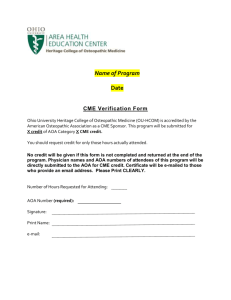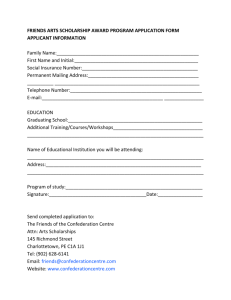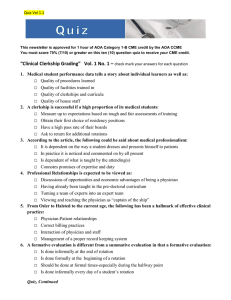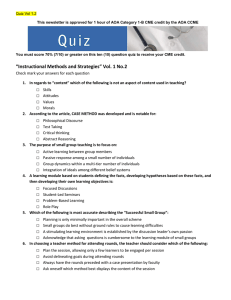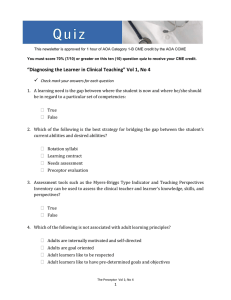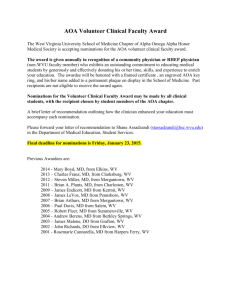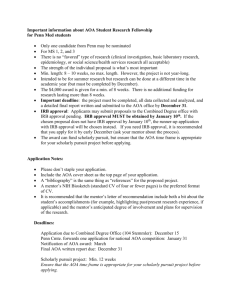Document 10743344
advertisement
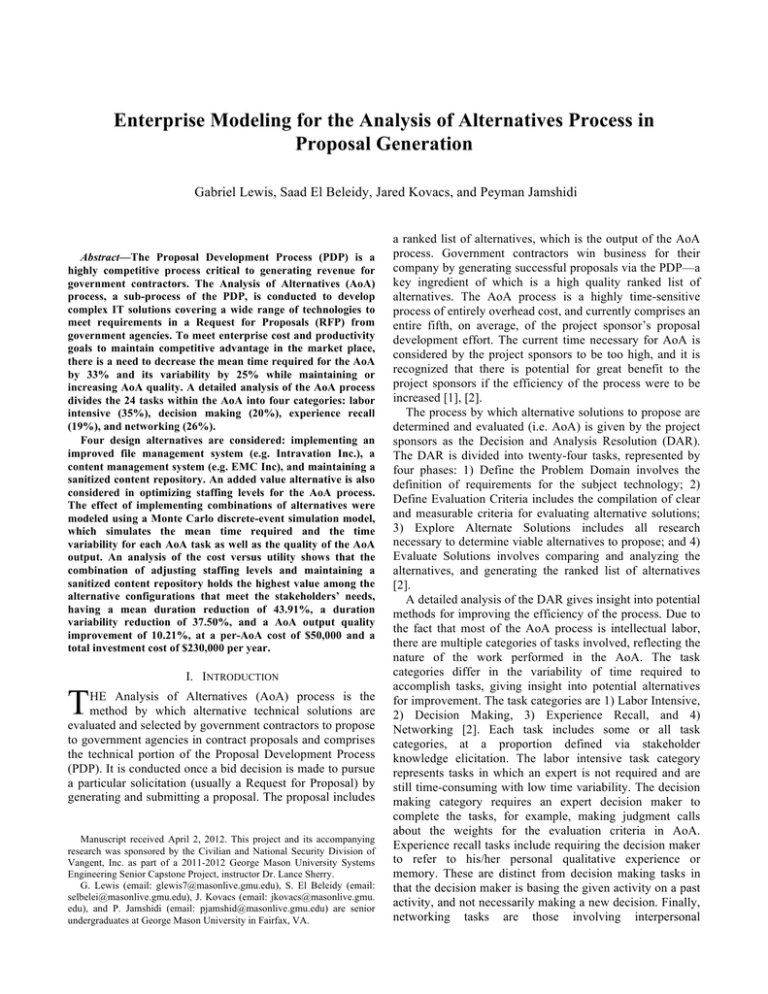
Enterprise Modeling for the Analysis of Alternatives Process in Proposal Generation Gabriel Lewis, Saad El Beleidy, Jared Kovacs, and Peyman Jamshidi Abstract—The Proposal Development Process (PDP) is a highly competitive process critical to generating revenue for government contractors. The Analysis of Alternatives (AoA) process, a sub-process of the PDP, is conducted to develop complex IT solutions covering a wide range of technologies to meet requirements in a Request for Proposals (RFP) from government agencies. To meet enterprise cost and productivity goals to maintain competitive advantage in the market place, there is a need to decrease the mean time required for the AoA by 33% and its variability by 25% while maintaining or increasing AoA quality. A detailed analysis of the AoA process divides the 24 tasks within the AoA into four categories: labor intensive (35%), decision making (20%), experience recall (19%), and networking (26%). Four design alternatives are considered: implementing an improved file management system (e.g. Intravation Inc.), a content management system (e.g. EMC Inc), and maintaining a sanitized content repository. An added value alternative is also considered in optimizing staffing levels for the AoA process. The effect of implementing combinations of alternatives were modeled using a Monte Carlo discrete-event simulation model, which simulates the mean time required and the time variability for each AoA task as well as the quality of the AoA output. An analysis of the cost versus utility shows that the combination of adjusting staffing levels and maintaining a sanitized content repository holds the highest value among the alternative configurations that meet the stakeholders’ needs, having a mean duration reduction of 43.91%, a duration variability reduction of 37.50%, and a AoA output quality improvement of 10.21%, at a per-AoA cost of $50,000 and a total investment cost of $230,000 per year. T I. INTRODUCTION HE Analysis of Alternatives (AoA) process is the method by which alternative technical solutions are evaluated and selected by government contractors to propose to government agencies in contract proposals and comprises the technical portion of the Proposal Development Process (PDP). It is conducted once a bid decision is made to pursue a particular solicitation (usually a Request for Proposal) by generating and submitting a proposal. The proposal includes Manuscript received April 2, 2012. This project and its accompanying research was sponsored by the Civilian and National Security Division of Vangent, Inc. as part of a 2011-2012 George Mason University Systems Engineering Senior Capstone Project, instructor Dr. Lance Sherry. G. Lewis (email: glewis7@masonlive.gmu.edu), S. El Beleidy (email: selbelei@masonlive.gmu.edu), J. Kovacs (email: jkovacs@masonlive.gmu. edu), and P. Jamshidi (email: pjamshid@masonlive.gmu.edu) are senior undergraduates at George Mason University in Fairfax, VA. a ranked list of alternatives, which is the output of the AoA process. Government contractors win business for their company by generating successful proposals via the PDP—a key ingredient of which is a high quality ranked list of alternatives. The AoA process is a highly time-sensitive process of entirely overhead cost, and currently comprises an entire fifth, on average, of the project sponsor’s proposal development effort. The current time necessary for AoA is considered by the project sponsors to be too high, and it is recognized that there is potential for great benefit to the project sponsors if the efficiency of the process were to be increased [1], [2]. The process by which alternative solutions to propose are determined and evaluated (i.e. AoA) is given by the project sponsors as the Decision and Analysis Resolution (DAR). The DAR is divided into twenty-four tasks, represented by four phases: 1) Define the Problem Domain involves the definition of requirements for the subject technology; 2) Define Evaluation Criteria includes the compilation of clear and measurable criteria for evaluating alternative solutions; 3) Explore Alternate Solutions includes all research necessary to determine viable alternatives to propose; and 4) Evaluate Solutions involves comparing and analyzing the alternatives, and generating the ranked list of alternatives [2]. A detailed analysis of the DAR gives insight into potential methods for improving the efficiency of the process. Due to the fact that most of the AoA process is intellectual labor, there are multiple categories of tasks involved, reflecting the nature of the work performed in the AoA. The task categories differ in the variability of time required to accomplish tasks, giving insight into potential alternatives for improvement. The task categories are 1) Labor Intensive, 2) Decision Making, 3) Experience Recall, and 4) Networking [2]. Each task includes some or all task categories, at a proportion defined via stakeholder knowledge elicitation. The labor intensive task category represents tasks in which an expert is not required and are still time-consuming with low time variability. The decision making category requires an expert decision maker to complete the tasks, for example, making judgment calls about the weights for the evaluation criteria in AoA. Experience recall tasks include requiring the decision maker to refer to his/her personal qualitative experience or memory. These are distinct from decision making tasks in that the decision maker is basing the given activity on a past activity, and not necessarily making a new decision. Finally, networking tasks are those involving interpersonal interaction and communication, for example, obtaining the opinion of a subject matter expert (SME). Table I shows the variabilities and percent composition of AoA for each task category [1], [2]. TABLE I AOA TASK CATEGORY VARIABILITIES AND PERCENT COMPOSITION OF A OA Key external information relevant to the decision-making processes is requested and obtained at several points in the process. This information includes 1) research from past AoA efforts, 2) industry research (including technology specifications, etc.), 3) customer knowledge, 4) subject matter expert opinions, and 5) internal survey responses. These areas of information are not under the control of those conducting AoA, and so a lack of available information may significantly delay the AoA process or lower the quality of the output by up to 25%. Also, the applicability of the information once obtained is unknown prior to obtaining it, therefore the usefulness of the information sought is highly variable. The lack of applicability of information may also lower the AoA output quality by up to 25% [2]. II. STAKEHOLDER ANALYSIS Key stakeholders are those within the project sponsor’s organization, Vangent Inc.’s Civilian and National Security Division, and have been categorized as those that are directly involved in driving and or performing AoA in the Proposal Development Process. A. Solutions Architects Solutions Architects (SA) are technical experts and are the primary employee responsible for conducting the entire AoA process. They perform market research and collect component specifications and data from vendors via interpersonal communication and/or reviewing product literature. They then organize the solutions development effort by combining available technologies and/or services into potential solutions that meet solicitor requirements. Finally, by performing an alternatives analysis, solutions architects provide a recommended solution to propose to the solicitor [1], [2]. B. Capture Managers If a bid is made, the capture managers develop a winning bid strategy by understanding the solicitor, the solution, and the competitive environment. They also oversee pricing, identify resources required, and manage process execution [1], [2]. C. Proposal Managers Proposal Managers develop and manage the proposal plan and schedule. They structure, develop, and write proposals around the RFP and may also leverage existing archived proposal information [1], [2]. D. Stakeholder Conflict There is a tension between the proposal development managers and the solutions architects. The managers’ goals of increasing proposal throughput and raise the probability of increasing revenue from won contracts, this would require an increase in the AoA throughput for proposals. However, the solutions architects’ constraints of limited time and personnel resources available to conduct AoA detracts from their ability to meet the demand required for an increase in proposal throughput [2]. III. NEED STATEMENT There is a need for a system to increase proposal development efficiency by reducing the mean time needed for Analysis of Alternatives by at least 33%, and the variability by 25%, while maintaining or increasing AoA proposed solution quality at acceptable cost. IV. DESIGN ALTERNATIVES Alternatives are developed based on a detailed understanding of the AoA process and further research with the goal of addressing the stakeholders’ needs. The two alternative types considered are 1) based on optimizing personnel resources to conduct AoA, 2) information technology solutions that will facilitate technical AoA material storage and retrieval. The defined alternatives are not considered as exclusive, as an integrated system comprised of a combination of alternatives that target the need may provide maximum utility to the stakeholders. A. Optimized Staffing Levels The optimized staffing levels alternative involves adding one additional solutions architect to aid in conducting AoA. This holds many potential benefits for the AoA process because the parallel nature of AoA tasks is not utilized when only one solutions architect is conducting AoA. There is expected to be a significant impact on the process duration and when an additional solutions architect aids in performing AoA. Of the 24 tasks identified throughout all stages of the AoA process, 21 of those tasks may be conducted in parallel with at least one other task, which can lead to a substantial increase in efficiency if an additional architect is available. Also, with an added solutions architect there is a larger pool of experience between the architects which may reduce the time necessary to conduct tasks relying on experience recall. With an increase in experience between the solutions architects there is expected to be more knowledge available to use in making decisions, for example, in defining key requirements, understanding the criteria needed for a specific AoA. It is expected that solutions architects will be able to conduct certain tasks simultaneously and the AoA process will therefore become more efficient. One potential drawback is the conflict in making decisions that can occur with the difference of opinions between two individuals, which could possibly cause tasks that require decision making to take longer to perform [2]. B. Information Technology Alternatives Key stakeholders have indicated that they currently use Microsoft Sharepoint for sharing files between architects, and that it does not provide the level of access or features that are needed, resulting in a low quality and under-utilized system [2]. The information technology alternatives that are proposed will seek to directly increase efficiency of performing all tasks in the AoA process by allowing for storage, retrieval and direct sharing of current and past technical solution material. Past proposal material could be used as a reference for current work and may even be directly applicable to the AoA at hand, potentially removing the need for new work in a given task of AoA. Two vendors of such products are considered because of existing license agreements or other relationships with the project sponsors. 1) File Management System A file management system is an IT solution that will allow files to be stored in a hierarchical structure on a backend server where they can be managed and accessed by solutions architects. It can be integrated with existing desktop productivity applications that architects are familiar with, and promotes intranet collaboration by increasing availability of information. A file management system can easily be scaled with the addition of more storage space, and should only require a minimal amount of technical support as it is not overly complex in terms of hardware and software. Specific user tailoring is limited to basic permissions required for accessing files, and search functionality is limited to filenames, tags, and attributes. The commercial-off-the-shelf (COTS) product considered is Intravation Inc.’s Virtual Proposal Center (VPC) [3]. 2) Content Management System A content management system extends on a file management system with additional benefits and features. It has more robust searching and indexing capabilities that allow for full-text and content searches within stored files and therefore is a higher quality solution (relative to the file management alternative) in terms of information accessibility and availability. It allows for users to be assigned roles based upon their file-access needs and includes authentication, file check-in and check-out, change tracking, and version control. These features accommodate greater enterprise security and integrity requirements. However, due to the much higher complexity associated with a content management system, it may require more technical support and training along with potential problems with authentication and access permissions which could delay availability of information. The COTS product that is considered is EMC’s Documentum [4]. 3) Sanitized Document Repository A sanitized document repository is essentially a collection of files that have been sanitized of proprietary and classified information. This will virtually eliminate any security risks associated with sharing of files and may provide quicker access to information since it will not require file specific access permissions. In addition, since it may be implemented as a simple shared drive, technical support is generally not necessary as this solution does not require special hardware or software. Potential drawbacks are that it will only contain sanitized documents, which could initially limit the quality and quantity of information available until additional files are added and the repository continues to grow. This alternative will reduce variability of the mean time duration of the AoA process since highly variable tasks such as those that require decision making, experience recall, and networking may be partly converted to labor intensive task of retrieving past proposal data. The new content that is created, which would have otherwise been unavailable to share between solutions architects, may contain similar decisions that have been made and analyses that have been conducted, thereby preventing the architect from having to start “fresh” on new AoAs. V. SIMULATION DESIGN A Monte Carlo Discrete-Event simulation is run for 1000 replications and models the current baseline AoA process, as defined by the DAR via stakeholder knowledge elicitation, as well as each of the various suggested alternatives. The simulation models both the basic structure and flow of the process as well as task categories and the effects of external information flow [1], [2]. A. Model Assumptions The model assumptions made in the simulation are as follows: 1) solutions architects work on one task at a time, 2) solutions architects work on one proposal at a time, 3) the four task categories adequately capture the labor done in the AoA process, and 4) all tasks are of equal importance to the quality of the AoA output. B. Simulation Inputs and Outputs Figure 1 shows the inputs and outputs of the simulation model. The simulation inputs are entirely exogenous, defined from process documentation and stakeholder knowledge elicitation. They are: 1) the AoA process structure definition, including the relative base duration random variable (considered as a percentage of the total expected time for AoA) for each of the 24 tasks, the percentage of each task category composing each task, and the inherent duration variability associated with the task categories; 2) task category efficiency indexes for each alternative; 3) the difficulty metric random variable for each AoA; 4) the availability of external information, determined via a probability distribution; 5) the applicability of external information, also determined via a probability distribution; and 6) the number of technologies (AoAs required) for each proposal. The outputs of the simulation model are entirely endogenous, calculated by the simulation model, and are: 1) the duration for each phase of the AoA and for the entire AoA; 2) the variability of the time duration for each phase and for the entire AoA; and 3) the quality metric for the AoA output. D. Design of Experiment The configurations of alternatives that comprise the design of experiment are shown in Table II. TABLE II SIMULATION DESIGN OF EXPERIMENT A1: Optimizing Staffing Levels, A2: Maintain a Sanitized Repository, A3: File Management, A4: Content Management In simulating each configuration, efficiency indexes were needed to calculate the effect of the tested configuration on the system—in particular the efficiency of each task category. These efficiency improvements for each alternative configuration were elicited from key stakeholder experts and they can be seen in Fig. 2 [2]. Fig. 1. Simulation Model Inputs and Outputs C. Simulation Calculations Several calculations are performed by the simulation, most importantly those for time delay (generating durations), time variability, and AoA output quality. The process time delay calculated by the simulation for each task is given by (1) with the variables being as follows: • Tc = Number of Task Categories • D = Inherent Process Delay for each Process • E = Task Category Efficiency Index • W = Task Category Weight (proportion of that task category in the process) • N = Number of Technologies/AoAs in the Proposal • V = Task Category Variability Factor (RV) • Tv = AoA Difficulty Factor (RV) Task Delay = (1) The total AoA duration is the sum of each task delay. And the time variability is calculated as the standard deviation of the mean time duration. The quality metric is summed over each external information flow point and is based on applicability, availability of information as shown in (2). • Av = Availability Metric • Ap = Applicability Metric Quality Metric = (2) Fig. 2. Efficiency Indexes for Simulation Configurations (A1: Optimizing Staffing Levels, A2: Maintain a Sanitized Repository, A3: File Management, A4: Content Management) VI. RESULTS A. Simulation Results Figure 3 shows the AoA percent time duration reduction from the baseline time for each configuration of alternatives considered. The configurations where several alternatives are included have a greater effect than single alternatives. Only six of the twelve configurations meet the desired minimum 33% decrease of AoA duration and 25% decrease in variability. Those configurations which meet the goals are marked with the darker coloring. Of these, the combination of optimized staffing levels, maintaining a sanitized repository, and implementing a content management system (A1, A2, A4) have the most significant effect at a 52% decrease in AoA duration from the baseline. Taken singly, the alternative with the greatest impact on mean time duration is the optimized staffing levels alternative, with a percent decrease of 36.53%. It should be noted that the configurations which do not meet the stakeholders’ need are those which do not include the optimizing staffing levels alternative. Fig. 3. Percent Duration Decrease for AoA for Each Simulation Configuration (A1: Optimizing Staffing Levels, A2: Maintain a Sanitized Repository, A3: File Management, A4: Content Management) Figure 4 shows the AoA time duration variability (1 sigma from the original duration) in standard deviations for the baseline and each alternative configuration. The configurations with multiple alternatives have a greater effect on the variability than any single alternatives, and only six configurations meet the goal of 25% variability reduction. The configurations with the greatest effect are the optimized staffing levels alternative and sanitized repository alternative coupled with either the file management or content management alternative (A1, A2, A3; or A1, A2, A4), both having a percent decrease in variability of 50%. Similarly to the results for AoA mean time duration, those configurations which do not include the optimized staffing levels alternative do not meet the variability reduction goal. The quality metric shows improvement in certain alternative configurations. It is seen that the sanitized Fig. 4. Percent Decrease for AoA Duration Variability for Each Simulation Configuration (A1: Optimizing Staffing Levels, A2: Maintain a Sanitized Repository, A3: File Management, A4: Content Management) repository alternative is the only one which significantly affects the quality metric. For those configurations involving that alternative, the quality metric increases by 10.18+/.04%, and for those that do not, the quality metric improves only marginally (up to a .04% improvement). B. Cost Analysis A cost analysis is conducted for each alternative. The optimized staffing levels alternative for one additional SA is estimated to be a $200,000 yearly burden resulting in a total five year cost of approximately $1,000,000 [2]. The file management alternative has a total five year cost estimated at $83,075. This includes first year cost of licensing 100 users at $75,000 plus annual maintenance of $1,615 per year [2]. The content management alternative has a total five year cost estimated at $202,740. This includes first year cost of licensing 100 users at $110,665 plus annual maintenance of $18,415 per year [5]. The sanitized repository alternative has an estimated five year cost of $150,000, this being calculated from the time necessary to sanitize AoA documents [2]. Since these alternatives are independent with regard to cost, the cost of any combination of these alternatives is the sum of the individual costs. These costs are reduced by cost saved from time saved in AoA duration reduction, as will be discussed. C. Stakeholders’ Utility Function A utility function with eight criteria is developed from stakeholder values elicitation, using the swing weight method. The most prominent factor in the utility function is the time reduction of alternatives, followed by the usability of the alternative for SAs. The integrability of the alternative is also given significant weight below usability, and is followed by the alternative’s effect on AoA quality. The tailorability ranks next, and the contract/business time variability, and scalability factors are weighted low (<.10) [2]. D. Cost-Benefit Analysis Results Figure 5 shows cost versus utility where cost is considered as the cost per AoA, which includes cost savings from time saved as a result of AoA duration reduction. Note that the sanitized repository alternative (A2) has a negative cost, or positive return on investment, of $2,400 per AoA. The upper-left corner represents the desirable region of the graph, having high utility and low cost, whereas the upperright region has high utility with high cost. The group of configurations in the upper right region contains those that include the optimized staffing levels alternative—a high value but high cost alternative. These are also the only configurations that meet the goals for AoA mean duration and duration variability reduction. The configurations in the upper-left corner are primarily technology-based alternatives. Fig. 5. Cost per AoA vs. Utility. The upper-left region is high utility, low cost, the upper-right region is high utility, high cost. Configurations in the upper-right meet the duration and variability reduction need. (A1: Optimizing Staffing Levels, A2: Maintain a Sanitized Repository, A3: File Management, A4: Content Management) E. Sensitivity Analysis A sensitivity analysis is performed on the weights used to score alternative configurations in the stakeholders’ utility function for the three highest-ranking configurations and the three greatest-weighted utility function criteria. Table III shows the amount by which the weight of each criterion would have to increase in order to overtake the highestranking alternative configuration utility. utility. This configuration yields a 43.9% decrease in the mean time duration for AoA a 37.5% decrease in the duration variability, 10.2% increase in AoA output quality, at a per-AoA cost of $50,000, and a total investment cost of $230,000 per year. The cost of the content management alternative (A4) has the potential to decrease significantly due to the possibility that the project sponsors have existing license agreements for the EMC Documentum content management tool, leading to potentially higher value if that alternative could be included. Table IV shows the ranking of alternative configurations by utility score. For a content management cost reduction of 35%, the configuration of optimized staffing levels, sanitized repository, and content management system (A1, A2, A4) would be nearer the desirable region on the cost vs. utility chart. It is therefore recommended that the optimized staffing levels and maintaining a sanitized repository alternatives be implemented, and the cost reduction potential of the content management system by further explored. TABLE IV ALTERNATIVE CONFIGURATION RANKS BY UTILITY TABLE III SENSITIVITY ANALYSIS FOR UTILITY WEIGHTS A1: Optimizing Staffing Levels, A2: Maintain a Sanitized Repository, A3: File Management, A4: Content Management It is also found that the combination of optimized staffing levels, maintaining a sanitized repository, and implementing a content management system (A1, A2, A4) utility scores of mean time, usability, and integrability must decrease by 38% and 50%, and 89% respectively in order to lose the highest ranking position and allow the combination of optimizing staffing levels and maintaining a sanitized repository hold the highest utility. An analysis of the lower-weighted criteria showed that no reasonable change in weights would alter the results. VII. DISCUSSION AND RECOMMENDATIONS Of the six alternative configurations that meet the duration and variability goals of 33% and 25% reduction respectively, optimizing staffing levels carries the least initial investment. The combination of optimizing staffing levels, maintaining a sanitized repository, and implementing a content management system carries the highest utility (though also the highest cost). However, the combination of optimized staffing levels and maintaining a sanitized repository is the nearest to the desirable region of the cost vs. utility chart of those configurations, though it does not carry the highest A1: Optimizing Staffing Levels, A2: Maintain a Sanitized Repository, A3: File Management, A4: Content Management ACKNOWLEDGMENT The Enterprise Modeling team would like to thank individuals who have contributed significantly to the completion of this project: Mr. Martin Nordberg III: primary stakeholder contact at Vangent; Mr. Steve Mcquinn: key Vangent stakeholder; Professor Lance Sherry (GMU Faculty Advisor and Instructor), and Paula Lewis (FAA), Juan Mantill (TA). REFERENCES [1] [2] [3] [4] [5] Authors Redacted Justification of Product/Solution Selection. Vangent, Inc., Arlington, VA, 2011. Knowledge Elicitation with Stakeholders and Subject Matter Experts, Vangent, Inc. Arlington, VA, 2011 - 2012. [Verbal] Intravation, Inc., Product Information, 2012. [Online]. Available: http://www.intravation.com/products/vpc.asp. Accessed February 2, 2012. EMC Corporation, EMC Documentum Architecture : Foundations and Services for Managing Content across the Enterprise. EMC Corporation, Hopkinton, MA, Nov 2009. [Online]. Available: http://www.emc.com/collateral/software/white-papers/h3411documentum-architecture-wp.pdf Dr. Ian Howels, Total Cost of Ownership for ECM, Alfresco Software, Inc., [Presentation]. January 2009.
